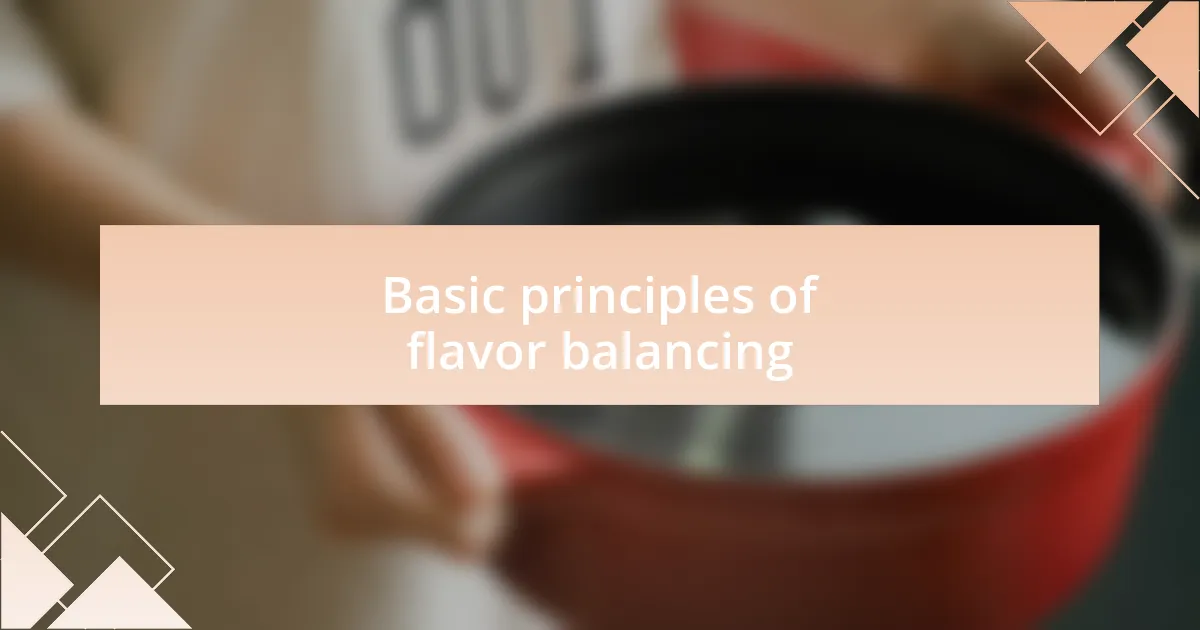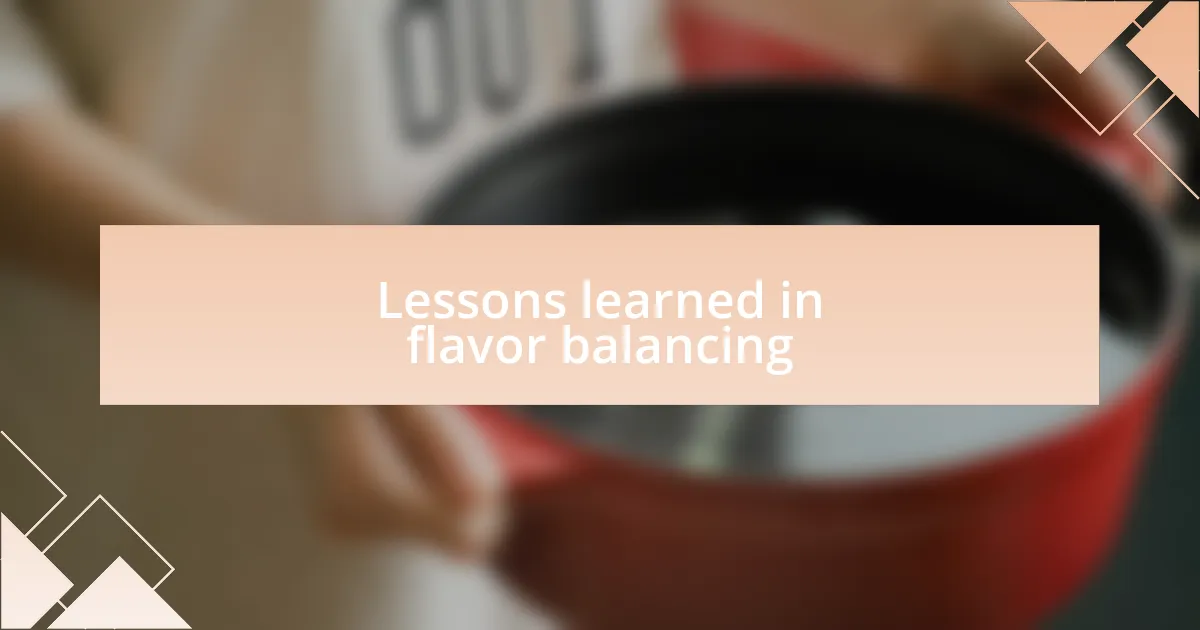Key takeaways:
- Flavor balancing enhances dishes by harmonizing sweet, salty, sour, and bitter notes, leading to a unique taste experience.
- Acidity and herbs are crucial tools in flavor balancing, transforming simple recipes into memorable dishes.
- Layering flavors gradually allows for deeper, richer tastes, while contrasting textures can elevate the overall dining experience.
- Experimenting with small adjustments, like adding salt or sweetness, can significantly enhance the complexity of a dish.

Understanding flavor balancing
Flavor balancing is a crucial skill that can elevate any dish from ordinary to extraordinary. I remember the first time I experimented with balancing sweetness and acidity—adding a splash of vinegar to a seemingly simple reduction sauce transformed it completely. Have you ever tasted something that just felt too flat? That’s often a sign that the flavors are not harmonizing yet.
When I first started cooking, I was overwhelmed by the myriad of flavors and how they interacted. I learned that balancing salty, sweet, sour, and bitter notes is essential. There was that memorable moment when I paired a rich, fatty duck breast with a tart cherry glaze; the interplay of flavors created a dance on my palate. It’s an exhilarating feeling when you discover that perfect harmony, isn’t it?
Understanding flavor balancing involves not only knowing the basic tastes but also recognizing how each ingredient influences the others. I often find myself asking, “Which flavor is dominant, and how can I support or enhance it?” This self-reflection leads me to experiment with spices and herbs, often leading to surprising results. Each adjustment brings me closer to achieving a unique flavor profile, making cooking truly feel like an art form.

Importance of flavor in cooking
Flavor is the heart of cooking, influencing not just taste but also the overall dining experience. I recall a dinner party where I prepared a simple tomato soup. By just adding a pinch of sugar and a dash of balsamic vinegar, the flavors burst to life, turning a basic recipe into a standout dish. Isn’t it fascinating how little tweaks can make such a huge impact?
When I think about flavor, I often reflect on the emotional connection we have with food. I remember savoring a well-spiced curry during a rainy evening; the warmth not only nourished my body but also my spirit. These moments remind me that flavor can evoke memories, transporting us to different times and places. Have you ever felt a rush of nostalgia from the smell of a particular dish?
In cooking, a well-balanced flavor profile can create an unforgettable experience. I’ve experimented with contrasting flavors, like the delightful clash of spicy and sweet in a jalapeño-infused chocolate dessert. The complexity of flavors not only excites our taste buds but also encourages creativity in the kitchen. How meaningful is it to convey emotions through something as simple as a plate of food?

Basic principles of flavor balancing
Finding the right balance of flavors is essential in any dish. One principle I always consider is the harmony between sweet, sour, salty, and bitter. I recall a time when I made a vinaigrette that was too sour—adding a hint of honey transformed it into a delightful dressing that elevated a simple salad. Doesn’t it make you wonder how such small adjustments can greatly enhance a dish?
Another key aspect I focus on is layering flavors. I once prepared a ragù, meticulously adding ingredients in stages. First, I sautéed the onions, then introduced garlic for depth, and finally added tomatoes to build a rich base. Each layer contributed something unique, reminding me that flavor is like a story—it unfolds gradually and captures your senses. Have you ever noticed how a dish evolves as it simmers?
Finally, contrasting flavors can create excitement on the palate. I experimented with a fruit salsa once, combining spicy jalapeños with sweet mangoes and tangy lime. The burst of flavors was invigorating and kept me coming back for more. Isn’t it intriguing how balancing opposites can lead to an unexpectedly delightful culinary experience?

Techniques for balancing flavors
When it comes to balancing flavors, I often use acidity as a secret weapon. One time, I was making a rich, creamy risotto, and it felt too heavy. A simple splash of lemon juice brightened everything up, adding a lively contrast that excited my taste buds. Isn’t it amazing how a little acidity can cut through richness and create that perfect harmony?
Another technique I find invaluable is the use of herbs and spices. I experimented with a simple roasted chicken, initially seasoned just with salt and pepper. After tossing in fresh rosemary and thyme, the aroma transformed my kitchen into a fragrant haven. Have you ever seen how herbs can elevate a dish from ordinary to extraordinary? They not only add flavor but also create an emotional connection to the food.
I also love playing with texture as a flavor-balancing technique. One memorable dish I crafted featured a crispy fried onion topping over creamy mashed potatoes. The contrast in textures was delightful, making every bite a surprising adventure. Doesn’t it feel satisfying when a dish plays with both flavor and mouthfeel, creating a multi-dimensional dining experience?

My approach to flavor balancing
When I approach flavor balancing, I often reflect on how contrasting flavors can amplify each other. For example, while crafting a dark chocolate dessert, I experimented with a sprinkle of sea salt. It was fascinating to taste how that tiny bit of salt amplified the chocolate’s richness, creating an entirely new layer of depth. Have you ever found a pinch of something unexpected completely transforming a dish?
Another key aspect of my flavor balancing is understanding the importance of sweetness. Recently, I made a tomato sauce that was more acidic than I intended. By stirring in a touch of honey, I was able to smooth out the sharpness without losing the integrity of the dish. It reminded me that balancing flavors is not just about counteracting; it’s about finding that sweet spot where flavors coexist harmoniously.
Finally, I think about layering flavors over time. When I prepare a curry, I often start by sautéing onions until they’re caramelized just right. That initial sweetness builds a foundation for the spices I later add, resulting in a balance that feels deliberate and intentional. Isn’t it incredible how one step can influence the entire composition of a dish? Each layer counts, and that’s where the magic happens.

Lessons learned in flavor balancing
In my journey toward mastering flavor balancing, I’ve discovered the transformative power of acidity. A memorable moment came when I was experimenting with a fruit salad: I added a splash of lime juice. Instantly, the dullness of the fruits was replaced with brightness. It made me realize that acidity not only enhances flavor but also revitalizes the entire dish—have you ever experienced that “aha!” moment where a simple addition changes everything?
Another lesson I learned is the magic of umami. I recall a time when I was preparing a vegetable stew and felt something was lacking. After some thought, I decided to toss in a few dried mushrooms. The depth that umami brought to the stew was astounding. It was as if the flavors came alive! Have you ever found yourself searching for that elusive flavor component that ties everything together?
Lastly, I’ve come to appreciate the role of texture in flavor balancing. When crafting a salad, I made sure to include crunchy nuts alongside tender greens. This contrast not only provided an engaging mouthfeel but also elevated the overall experience of the dish. It’s interesting how something as simple as texture can influence our perception of flavor—do you think texture plays a pivotal role in your culinary creations too?

Tips for better flavor balancing
When it comes to balancing flavors, don’t underestimate the importance of salt. I remember a time when I was preparing a tomato sauce that desperately needed something extra. After I added just a pinch of salt, the flavors blossomed. It’s incredible how enhancing sweetness and acidity with salt can transform a dish. Have you ever tasted something and thought, “It just needs a little more?” Often, that “little more” is simply salt.
Another key aspect I’ve found is to layer flavors rather than throwing everything in at once. While cooking a risotto, I took my time adding the broth gradually, allowing each addition to meld with the ingredients. This method not only deepened the flavor but also created a beautiful creaminess. Have you tried layering flavors in your cooking? It really can make a noticeable difference.
Lastly, don’t shy away from experimenting with herbs and spices. I once created a simple dish of roasted vegetables and decided to sprinkle fresh dill over the top. What a revelation! The fresh herb added a vibrant and aromatic note that transformed the entire dish. It prompts me to ask: How often do you allow yourself the freedom to explore new herbal combinations? The right herb can elevate a meal to new heights, revealing flavors you may not have realized were there.